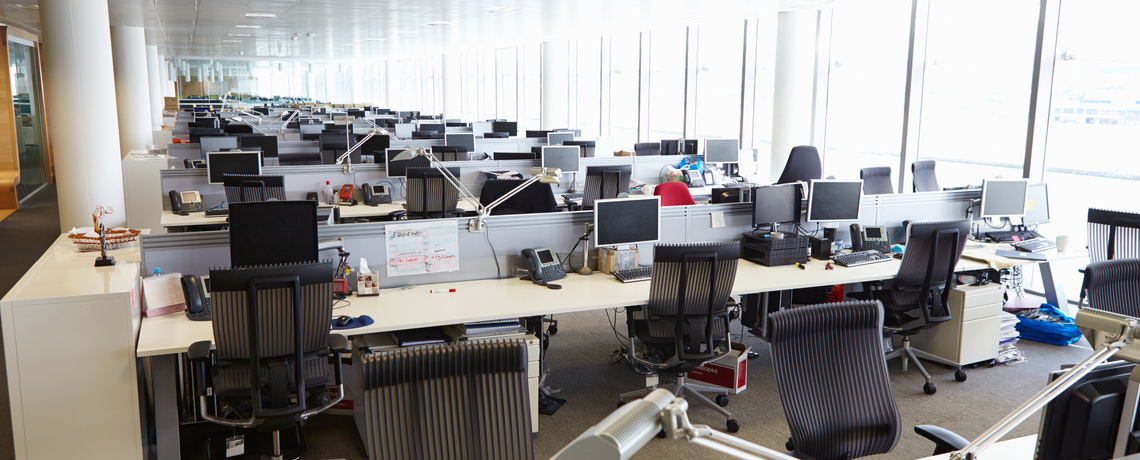
- Author: Nina Hendy
- Posted: June 22, 2021
Empty Office Buildings a Headache for CFOs
Finance heads have been grappling with the challenging task of navigating how much office space they need in a post-Covid world. And it is no mean feat.
When professional services firm EY sent its 6500-strong workforce home at the start of the pandemic, it left an eye-watering 23 floors of office space covering 25,000 metres empty. It was an expensive decision that the company says it made to save lives and jobs.
This pattern that has played out all across the country as corporate offices are vacated. And now that employees have had a taste of working from home, many are demanding a hybrid model that allows greater flexibility once the Covid-19 crisis ends.
A PwC report reveals that occupancy rates took a nosedive across CBD’s as a greater proportion of workers swapped their CBD commute to work from their kitchen table.
It’s a quandary that CFOs have been grappling with for more than a year now, which doesn’t look likely to be resolved anytime soon.
Crystal ball gazing
CFO for office leasing specialists CBRE Fiona Keys admits it has been hard to predict just how much office space will be needed into the future. While remote working is here to stay, many companies are adopting a hybrid model, where offices continue to play an important role.
“It was thought that office space would be less of a requirement after Covid-19, but the fact is that the actual office space shrinkage has been just nine per cent across the globe,” Keys says.
A strong focus on employee health has also been important as companies grapple with metal health issues amid rolling international border closures and lockdowns – Melbourne is just emerged from its fourth lockdown in a year.
Deciding how much office space will be needed in the future is a decision that organisations of all shapes and sizes are having to make. With offices in Brazil and Australia, finance manager of digital agency Talk Agency Vicki Giaquinto says the hybrid model has cost more than some might think.
“Our fully remote team saves us approximately 9 to 10 per cent in operational expenses, however the costs of managing a truly innovative, inclusive, culturally relevant WFH or hybrid mode are higher than most think.
“We have found that there are large costs around going the extra mile that is needed to really make WFH or hybrid work – team building, games, activity, etc,” she says.
“We are managing costs or considering ways to manage costs around home internet, home electricity, office furniture and cultural costs – remote team meet-ups, allowances, travel, etc,” Giaquinto says.
Cost avoidance
Commercial real estate has a particularly long lead time between making a strategic decision and realising the savings or cost avoidance, adds Bryan Froud is the director of consulting for real estate services firm JJL.
Pre-Covid, a typical open plan office would have approximately 60 per cent of floorspace dedicated to individual workspaces. “A hybrid working model means employees will predominantly be coming into the office to collaborate and socialise. So we’ll see the amount of space dedicated to individuals drastically decrease, with more spaces created for knowledge-sharing,” Froud says.
The reduced floor space that companies need will depend on how adaptive and resilient their workforce is to working in a hybrid way. If the organisation was already using an activity-based working model – where individuals own a desk – then we’ve seen some looking to divest and reduce their portfolios by as much as 50 to 70 per cent.
Though the more conservative organisations, where employees still have their own desks or offices, it’s likely they would only be able to reduce by 20 to 30 per cent, as they navigate the organisational and behaviour changes required to adopt and adjust to hybrid working.
One challenge many occupiers are grappling with is managing the ‘peak’ days where the majority of the workforce is in the office.
“The majority of employees in hybrid organisations work two to three days in the office, with Tuesday to Thursday being the most popular days. So occupiers are exploring how to make their portfolios more flexible, without carrying surplus workspace Monday to Friday, with some looking for landlords that managing co-working facilities on site or incorporate more flexible designs that allow them to expand and contract quickly,” Froud says.
Lay of the land
“For organisations with less expiry three to five years away, they may have found immediate savings through reduced outgoings and operating expenses during the lockdown as lighting and heating was switched off, though they would still be paying rent for an empty space.
“We’re seeing occupiers realise that hybrid working is the next normal typically requires less space, a different space and most are opting to relocate into a new space,” Froud says.
Clients whose lease expiry is less than 18 months away, many are already approaching the market to reduce their portfolio by at least 30 per cent, he says.
“Many occupiers are looking to relocate because they realise hybrid workplaces requires a different design and want to take advantage of landlord incentives to help pay for the capital required to fit out a new premises.”
The trend is likely to continue as long as the pandemic continues, as organsiations look to build flexible and resilient a property portfolio. “In the past, most business continuity plans only ever one site or city that was shut down due to an emergency. Now, occupiers understand how they can have a fully remote workforce. With real estate as typically the third or fourth highest cost for organisations, there is substantial opportunity for those companies that find the right balance in the next normal,” Froud says.
Meanwhile, sub-leasing does provide an opportunity to reduce expenditure, though they’re likely to get less from a sub-tenant as they’re adding more office space to a market with low rental rates, higher vacancy and attractive landlord incentive, Froud explains.
But PwC’s report believes that the so-called ‘death of the CBD’ is grossly exaggerated. As the risks of Covid-19 recede, people will return to offices, with 66 per cent of respondents revealing they would prefer to connect with people at a physical workplace.
So while organisations appear to be forging on with a hybrid model this year, what 2022 and beyond will bring is anyone’s guess.








